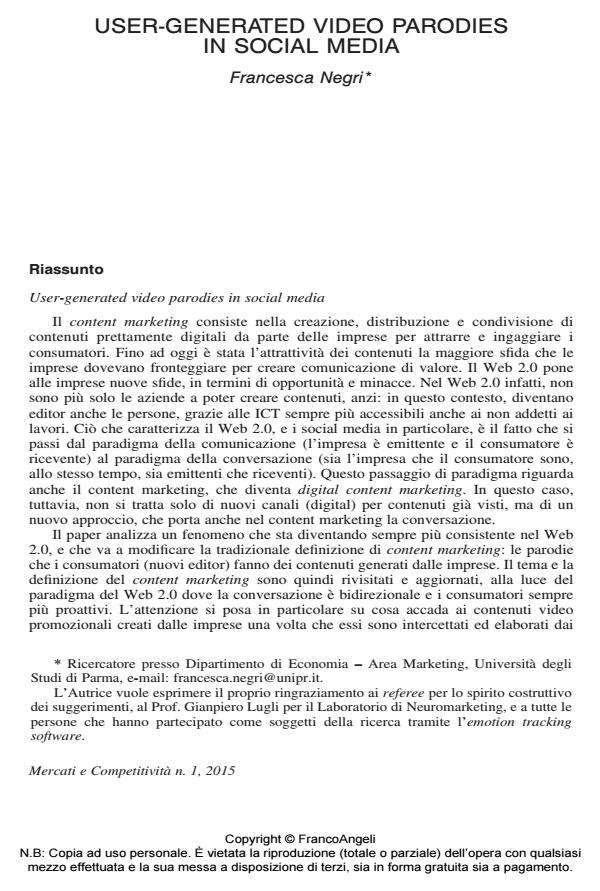User-generated video parodies in social media
Titolo Rivista MERCATI E COMPETITIVITÀ
Autori/Curatori Francesca Negri
Anno di pubblicazione 2015 Fascicolo 2015/1
Lingua Italiano Numero pagine 21 P. 75-95 Dimensione file 114 KB
DOI 10.3280/MC2015-001005
Il DOI è il codice a barre della proprietà intellettuale: per saperne di più
clicca qui
Qui sotto puoi vedere in anteprima la prima pagina di questo articolo.
Se questo articolo ti interessa, lo puoi acquistare (e scaricare in formato pdf) seguendo le facili indicazioni per acquistare il download credit. Acquista Download Credits per scaricare questo Articolo in formato PDF

FrancoAngeli è membro della Publishers International Linking Association, Inc (PILA)associazione indipendente e non profit per facilitare (attraverso i servizi tecnologici implementati da CrossRef.org) l’accesso degli studiosi ai contenuti digitali nelle pubblicazioni professionali e scientifiche
Il content marketing consiste nella creazione, distribuzione e condivisione di contenuti prettamente digitali da parte delle imprese per attrarre e ingaggiare i consumatori. Fino ad oggi è stata l’attrattività dei contenuti la maggiore sfida che le imprese dovevano fronteggiare per creare comunicazione di valore. Il Web 2.0 pone alle imprese nuove sfide, in termini di opportunità e minacce. Nel Web 2.0 infatti, non sono più solo le aziende a poter creare contenuti, anzi: in questo contesto, diventano editor anche le persone, grazie alle ICT sempre più accessibili anche ai non addetti ai lavori. Ciò che caratterizza il Web 2.0, e i social media in particolare, è il fatto che si passi dal paradigma della comunicazione (l’impresa è emittente e il consumatore è ricevente) al paradigma della conversazione (sia l’impresa che il consumatore sono, allo stesso tempo, sia emittenti che riceventi). Questo passaggio di paradigma riguarda anche il content marketing, che diventa digital content marketing. In questo caso, tuttavia, non si tratta solo di nuovi canali (digital) per contenuti già visti, ma di un nuovo approccio, che porta anche nel content marketing la conversazione. Il paper analizza un fenomeno che sta diventando sempre più consistente nel Web 2.0, e che va a modificare la tradizionale definizione di content marketing: le parodie che i consumatori (nuovi editor) fanno dei contenuti generati dalle imprese. Il tema e la definizione del content marketing sono quindi rivisitati e aggiornati, alla luce del paradigma del Web 2.0 dove la conversazione è bidirezionale e i consumatori sempre più proattivi. L’attenzione si posa in particolare su cosa accada ai contenuti video promozionali creati dalle imprese una volta che essi sono intercettati ed elaborati dai fan, in particolare nella forma della video parodia condivisa sulla piattaforma YouTube. Le analisi condotte, attraverso il calcolo dell’Engagement Rate, una content analysis seguita dalla sentiment e un esperimento di emotion tracking tramite un software di face reading, dimostrano che le video parodie prodotte dai consumatori (User-Generated Video Parodies) sono effettivamente in grado di creare valore addizionale (in termini di percezione più positiva della comunicazione originale, opportunità di viralità e, infine, di costruzione di una relazione con il consumatore) rispetto a quello generato dagli sforzi editoriali e creativi delle sole imprese che investono nel content marketing.
Parole chiave:Digital content marketing, social media, User Generated Content, parodia, video, YouTube.
- Exploring the palm oil crisis through the lens of different social media: an analysis of facebook, youtube and twitter contents Matteo Corciolani, Giacomo Gistri, Stefano Pace, in MERCATI & COMPETITIVITÀ 4/2016 pp.43
DOI: 10.3280/MC2016-004004
Francesca Negri, User-generated video parodies in social media in "MERCATI E COMPETITIVITÀ" 1/2015, pp 75-95, DOI: 10.3280/MC2015-001005